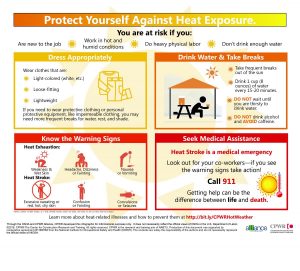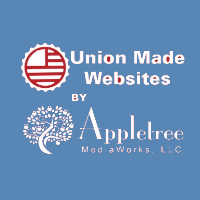As temperatures continue to rise this summer, it’s important to remember to stay safe and avoid any heat-related illness. The Center for Construction Research and Training offers various resources for workers to stay safe during the summer heat.
“It’s important that our members know the signs of heat illness and that they keep an eye on their brothers and sisters this summer,” said International President Lonnie R. Stephenson. “And just as important, we all need to know our rights under OSHA and that no one should be working under unsafe conditions.”
This summer is expected to be hotter than normal for most of the lower 48 states in the U.S., according to Weather.com, which is all the more reason to know the signs of heat-related illness, how to prevent them and what a worker’s rights are in terms of heat safety on the job.
National Institute for Occupational Safety and Health info PDF on preventing heat stroke at work.
While there is no federal standard for heat safety, the Occupational Safety and Health Administration does have guidelines, as well as its “Water. Rest. Shade.” Heat Illness Prevention campaign. The campaign’s website states:
Under OSHA law, employers are responsible for providing workplaces free of known safety hazards. This includes protecting workers from extreme heat. An employer with workers exposed to high temperatures should establish a complete heat illness prevention program.
-Provide workers with water, rest and shade.
-Allow new or returning workers to gradually increase workloads and take more frequent breaks as they acclimatize, or build a tolerance for working in the heat.
-Plan for emergencies and train workers on prevention.
-Monitor workers for signs of illness.
The Centers for Disease Control has also posted information on heat stress in construction. Published on May 21, the blog post includes a note on COVID-19 and recommends that workers not share water bottles or cups and to maintain social distancing. It also noted that the “buddy system” may be harder to do under such circumstances and that, especially with everyone wearing masks, that, “Workers may need to ask each other questions about how they are feeling during the workday to assess for signs of heat-related illness among their co-workers.”
Each year, an average of about 658 people succumb to extreme heat, according to the CDC. Heat-related illnesses include heat stroke, heat exhaustion, heat cramps, heat rash and severe dehydration — all of which are preventable.
Acclimatization is particularly important. Research shows that it can take one to two weeks to adjust to the heat, and a 2016 study found that, of 23 heat-related deaths, 17 died within the first three days on the job.
Signs of heat exhaustion include muscle cramping, fatigue, headache, nausea or vomiting, and dizziness or fainting. If left untreated, heat exhaustion can lead to heat stroke, a potentially life-threatening condition.
Heat stroke symptoms include:
A body temperature greater than 103 degrees Fahrenheit (39.4 degrees Celsius)
-Red, hot, and dry skin (no sweating)
-Rapid, strong pulse
-Throbbing headache
-Dizziness
-Nausea
-Confusion
-Unconsciousness
Along with the National Institute for Occupational Safety and Health, OSHA developed an app, available for iPhones and Androids, that calculates the heat index in your location and gives you a corresponding risk level. The app also provides information on symptoms of heat-related illness and first aid.
For more information on how to stay safe, visit OSHA’s heat safety page. Additional information can also be found at the Center for Construction Research and Training.
Article first appeared at IBEW‘s website on June 12, 2020.




















